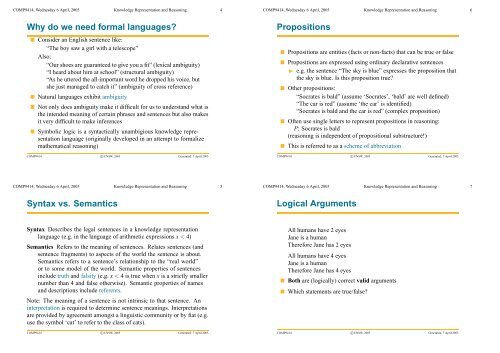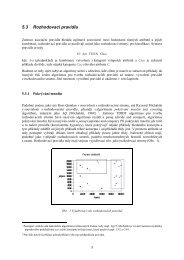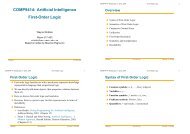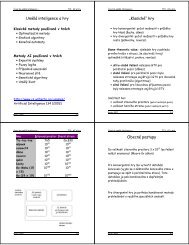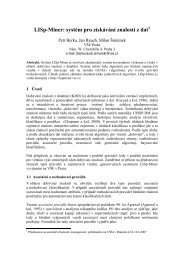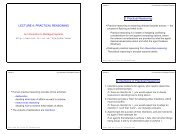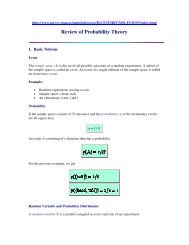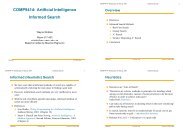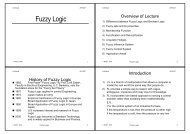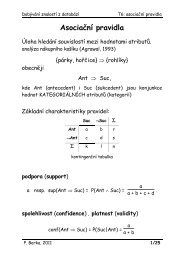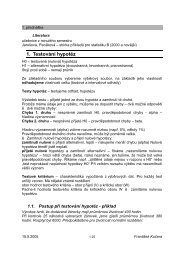COMP9414: Artificial Intelligence Knowledge Representation ... - Sorry
COMP9414: Artificial Intelligence Knowledge Representation ... - Sorry
COMP9414: Artificial Intelligence Knowledge Representation ... - Sorry
Create successful ePaper yourself
Turn your PDF publications into a flip-book with our unique Google optimized e-Paper software.
<strong>COMP9414</strong>, Wednesday 6 April, 2005 <strong>Knowledge</strong> <strong>Representation</strong> and Reasoning 4<br />
Why do we need formal languages?<br />
Consider an English sentence like:<br />
“The boy saw a girl with a telescope”<br />
Also:<br />
“Our shoes are guaranteed to give you a fit” (lexical ambiguity)<br />
“I heard about him at school” (structural ambiguity)<br />
“As he uttered the all-important word he dropped his voice, but<br />
she just managed to catch it” (ambiguity of cross reference)<br />
Natural languages exhibit ambiguity<br />
Not only does ambiguity make it difficult for us to understand what is<br />
the intended meaning of certain phrases and sentences but also makes<br />
it very difficult to make inferences<br />
Symbolic logic is a syntactically unambigious knowledge representation<br />
language (originally developed in an attempt to formalize<br />
mathematical reasoning)<br />
<strong>COMP9414</strong> c○UNSW, 2005 Generated: 7 April 2005<br />
<strong>COMP9414</strong>, Wednesday 6 April, 2005 <strong>Knowledge</strong> <strong>Representation</strong> and Reasoning 6<br />
Propositions<br />
Propositions are entities (facts or non-facts) that can be true or false<br />
Propositions are expressed using ordinary declarative sentences<br />
◮ e.g. the sentence “The sky is blue” expresses the proposition that<br />
the sky is blue. Is this proposition true?<br />
Other propositions:<br />
“Socrates is bald” (assume ‘Socrates’, ‘bald’ are well defined)<br />
“The car is red” (assume ‘the car’ is identified)<br />
“Socrates is bald and the car is red” (complex proposition)<br />
Often use single letters to represent propositions in reasoning:<br />
P: Socrates is bald<br />
(reasoning is independent of propositional substructure!)<br />
This is referred to as a scheme of abbreviation<br />
<strong>COMP9414</strong> c○UNSW, 2005 Generated: 7 April 2005<br />
<strong>COMP9414</strong>, Wednesday 6 April, 2005 <strong>Knowledge</strong> <strong>Representation</strong> and Reasoning 5<br />
Syntax vs. Semantics<br />
<strong>COMP9414</strong>, Wednesday 6 April, 2005 <strong>Knowledge</strong> <strong>Representation</strong> and Reasoning 7<br />
Logical Arguments<br />
Syntax Describes the legal sentences in a knowledge representation<br />
language (e.g. in the language of arithmetic expressions x < 4)<br />
Semantics Refers to the meaning of sentences. Relates sentences (and<br />
sentence fragments) to aspects of the world the sentence is about.<br />
Semantics refers to a sentence’s relationship to the “real world”<br />
or to some model of the world. Semantic properties of sentences<br />
include truth and falsity (e.g. x < 4 is true when x is a strictly smaller<br />
number than 4 and false otherwise). Semantic properties of names<br />
and descriptions include referents.<br />
Note: The meaning of a sentence is not intrinsic to that sentence. An<br />
interpretation is required to determine sentence meanings. Interpretations<br />
are provided by agreement amongst a linguistic community or by fiat (e.g.<br />
use the symbol ‘cat’ to refer to the class of cats).<br />
<strong>COMP9414</strong> c○UNSW, 2005 Generated: 7 April 2005<br />
All humans have 2 eyes<br />
Jane is a human<br />
Therefore Jane has 2 eyes<br />
All humans have 4 eyes<br />
Jane is a human<br />
Therefore Jane has 4 eyes<br />
Both are (logically) correct valid arguments<br />
Which statements are true/false?<br />
<strong>COMP9414</strong> c○UNSW, 2005 Generated: 7 April 2005


